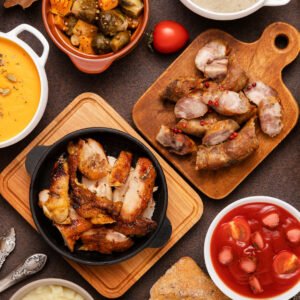Traditional Pakistani Dishes You Must Try Pakistan is a country known for its rich culture, vibrant heritage, and—most of all—its flavorful and aromatic cuisine. From sizzling street food to slow-cooked feasts, traditional Pakistani dishes are a celebration of spices, regional influences, and culinary art. Whether you’re a food lover looking to explore new flavors or a Pakistani longing for a taste of home, this article dives into the top 10 traditional Pakistani dishes you absolutely must try.

Top 10 Traditional Pakistani Dishes You Must Try
1. Biryani
No list of traditional Pakistani dishes is complete without Biryani. This aromatic rice dish, layered with spiced meat, saffron, and fried onions, is a national favorite. Originating from the Mughal kitchens, Biryani has countless regional versions such as Sindhi Biryani, Karachi Biryani, and Lahori Biryani. This dish also take part in Traditional Pakistani Dishes
Why You Must Try It: Biryani is the perfect marriage of basmati rice and marinated meat, delivering a burst of flavor in every bite.
Pro Tip: Enjoy it with raita (yogurt sauce) and salad for a complete experience.
2. Nihari
Nihari is a slow-cooked meat stew traditionally eaten for breakfast, especially on weekends. It originated in the royal kitchens of Delhi and found its home in Pakistan after partition.
Why You Must Try It: The rich, spicy gravy and melt-in-your-mouth meat make Nihari a soulful dish, especially when paired with naan or kulcha.
Pro Tip: Top it with fried onions, lemon juice, and fresh coriander to enhance the flavor.
3. Haleem
Cooks prepare Haleem, a protein-packed porridge, using a blend of wheat, barley, lentils, and meat (usually beef or chicken). They slow-cook it for several hours to achieve a thick, paste-like consistency. This dish also take part in Traditional Pakistani Dishes
Why You Must Try It: It’s not only delicious but also very filling and nutritious. A perfect dish for Ramadan or winter evenings.
Pro Tip: Garnish with fried onions, lemon, green chilies, and fresh mint.
4. Saag with Makki di Roti
As a Punjabi winter staple, cooks slowly prepare Saag (usually mustard greens) with spices and traditionally serve it with Makki di Roti (corn flatbread). This dish also take part in Traditional Pakistani Dishes
Why You Must Try It: This earthy, hearty dish is comforting and full of fiber and nutrients.
Pro Tip: Add a dollop of homemade butter or desi ghee for an authentic flavor.
5. Karahi
Karahi is a spicy stir-fry dish made with chicken, mutton, or beef, cooked in a wok-like utensil called a karahi. It’s a star item in both roadside dhabas and upscale restaurants.
Why You Must Try It: With its thick tomato-based gravy and bold spices, Karahi is both rustic and gourmet.
Pro Tip: Pair it with naan and a cold glass of lassi for a fulfilling meal.
6. Chapli Kebab
Originating from Peshawar, Chapli Kebab is a minced meat patty seasoned with ground spices, tomatoes, and herbs.
Why You Must Try It: Crispy on the outside and juicy on the inside, Chapli Kebabs are a meaty delight and perfect as a snack or part of a full meal.
Pro Tip: Serve with naan and chutney for the best experience.
7. Seekh Kebab
These skewered minced meat kebabs are seasoned with traditional spices and grilled to perfection. A staple at BBQ parties and weddings.
Why You Must Try It: Smoky, spicy, and juicy—Seekh Kebabs are a meat lover’s dream.
Pro Tip: Pair with mint chutney and onion rings for a zesty bite.
8. Aloo Gosht
Aloo Gosht is a curry made with tender meat and potatoes, cooked in a flavorful gravy. It’s a comfort food in many Pakistani households.
Why You Must Try It: Simple yet deeply flavorful, this dish goes well with both rice and roti.
Pro Tip: Cook it in a pressure cooker to speed up the process without compromising on taste.
9. Daal Chawal
This humble combination of lentil curry and boiled rice is a staple in almost every Pakistani home.
Why You Must Try It: It’s light, comforting, and easy to digest—ideal for both kids and adults.
Pro Tip: Add a spoonful of achar (pickle) and fried onions for a spicy kick.
10. Samosa and Pakora
Though typically considered snacks, Samosas and Pakoras are essential to Pakistani cuisine, especially during Ramadan and rainy days.
Why You Must Try It: It delivers crunch, spice, and bold flavors—there’s so much to love!
Pro Tip: Enjoy with mint chutney or imli (tamarind) sauce for that extra zing.
Cultural Significance of Traditional Pakistani Dishes
Each traditional Pakistani dish carries a story of culture, history, and heritage. Meals are more than sustenance—they’re a medium of love, celebration, and unity. From Eid gatherings to weddings and family dinners, food is the heart of every event.
These dishes are also deeply regional. A Karahi in Lahore might taste different from one in Quetta due to local preferences, spice levels, and cooking techniques. Understanding and tasting these differences not only broadens your palate but also brings you closer to Pakistan’s culinary roots.
Ingredients That Define Pakistani Cuisine
What makes traditional Pakistani dishes stand out? It’s the generous use of spices and herbs. Ingredients like cumin, coriander, turmeric, cardamom, cloves, and red chili powder define the flavor profile. Garlic, ginger, and onions form the base of most dishes. Garnishes like fresh coriander, mint, green chilies, and lemon juice add the final touch.
Another key factor is the cooking method—slow-cooking is a common technique to allow flavors to fully develop and meld. This is why dishes like Nihari, Haleem, and Saag taste even better the next day.
How to Start Exploring Traditional Pakistani Dishes
If you’re new to Pakistani cuisine or want to introduce it to others, start with crowd-pleasers like Biryani, Seekh Kebabs, or Aloo Gosht. These are relatively simple to make and almost universally loved. Use fresh ingredients and don’t be afraid of spices—balanced seasoning is the soul of Pakistani food.
You can also join local food communities online, follow Pakistani chefs on YouTube, or attend cultural food festivals. Cooking and eating traditional Pakistani dishes can be an adventure—one that’s rewarding and delicious.
Frequently Asked Questions
What are the most popular traditional Pakistani dishes?
Traditional Pakistani cuisine features popular dishes such as Biryani, Nihari, Haleem, Karahi, Saag, and various types of Kebabs. These meals are widely enjoyed in households and restaurants across the country.
How does Pakistani cuisine differ from Indian cuisine?
While both cuisines share similar ingredients and cooking techniques, Pakistani food typically incorporates more meat, especially beef and mutton, and relies on stronger spices. Additionally, it reflects unique regional influences from Afghan, Persian, and Central Asian traditions.
What are some traditional vegetarian dishes in Pakistan?
Vegetarian options include Daal (lentils), Aloo Bhujia (spiced potatoes), Chana Masala (chickpeas), and Saag (leafy greens). These dishes are flavorful and widely enjoyed.
Which spices are commonly used in Pakistani cooking?
Pakistani cuisine features spices such as cumin, coriander, turmeric, red chili powder, garam masala, cardamom, cinnamon, cloves, and bay leaves. Fresh ingredients like garlic, ginger, and green chilies are also essential in many dishes.
Is Pakistani food considered healthy?
Pakistani food can be both nutritious and indulgent. Dishes like Daal, grilled Kebabs, and Saag offer essential nutrients, while rich meals such as Biryani and Nihari are more decadent.
Where can I find authentic Pakistani food outside of Pakistan?
Authentic Pakistani food is available in many major cities worldwide, particularly in areas with South Asian communities. Look for Pakistani restaurants, halal dining establishments, or cultural festivals for traditional cuisine.
Final Thoughts
Traditional Pakistani dishes are more than just food—they’re a representation of our culture, hospitality, and history. Whether it’s the richness of Nihari, the vibrant flavors of Biryani, or the comfort of Daal Chawal, each dish tells a story.
So the next time you’re craving something exotic, flavorful, and satisfying, try one of these traditional Pakistani dishes. Your taste buds will thank you!
If you are looking for restaurants information in Lahore you can read this
Big Shoutout to the guys who made this blog happen UDM.














